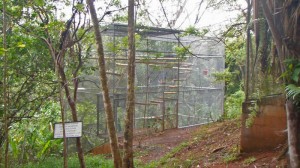The Making Of A Monkey Troop
By KSTR Vet Pia Martin
 White face monkeys are very intelligent new world monkeys. They are omnivores who eat fruits, veggies, insects, eggs, lizards and almost anything that moves. In the wild they are always in the canopy and travel during the morning and afternoon in troops of 7 or more individuals. They are very active, curious, and playful all the time. Their big eyes, pink nose, stand up position and fingers make them very similar to people. Many humans get confused and think that this cute animal will become fabulous and funny pets. However they can’t be more wrong.
White face monkeys are very intelligent new world monkeys. They are omnivores who eat fruits, veggies, insects, eggs, lizards and almost anything that moves. In the wild they are always in the canopy and travel during the morning and afternoon in troops of 7 or more individuals. They are very active, curious, and playful all the time. Their big eyes, pink nose, stand up position and fingers make them very similar to people. Many humans get confused and think that this cute animal will become fabulous and funny pets. However they can’t be more wrong.
White face monkeys need other monkeys to properly play, exercise, communicate, and to have normal behavioral development. They need to move at least 20 km per day to forage and hunt for food, but also to exercise. They travel extensively eating bugs and maintaining a balance in the insect population as well as dispersing seeds throughout the rainforest to get other trees to germinate and grow.
When they are in a captive environment, very few people can give them all the elements they need to be physically and mentally healthy. They then get sick and stressed, becoming aggressive and dangerous. That’s when the “owner” decides they don’t want them anymore but now it’s too late to release them to the wild. These monkeys become imprinted and depend on people for feeding and taking care of them.
MINAET brought us 3 monkeys from 3 places in Costa Rica with the same story. Our goal then was to introduce them to each other, let them learn how to interact and communicate with each other. This is a slow process that takes many months. Fortunately, it has been very successful, the trio gets along perfectly! The leader is the female, she is the oldest and most dominant. Then we have a juvenile male and a young male. The youngest is often observing what the bigger guys are doing, so he learns and imitates them. For example, if we present a new food he will not touch it until the older ones do. The bigger ones will, on the other hand, be extra caring for the young one. They all play together, groom each other, and if a threat is observed (like another monkey passing by) – they react and defend their territory together; they have become a troop.
Since the troop is now ready, we are finishing a common cage for them. It’s a huge cage with live trees, dead branches, ropes, reused materials like tires, swings, places to hide, places to sun-bathe and hammocks under the shade. The diet is a balanced and varied food plan of fruits, veggies, carbs, and proteins placed in bowls but also hidden and hanging to stimulate the foraging behavior.
Our two objectives are:
1. Give them the best quality of life they can have in captivity since they can’t be released
2. Teach people about this species, their story, and their significance in the rainforest.
Soon we will be transferring them to this new cage and you will be able to see them by taking the KSTR morning or afternoon tour. Email us to piadvm@kstr.org or jennifer@kstr.org for more information.

